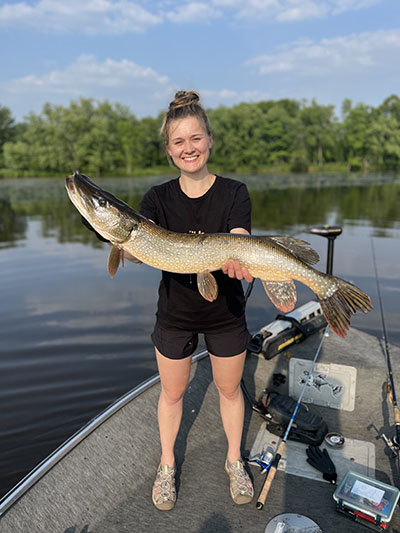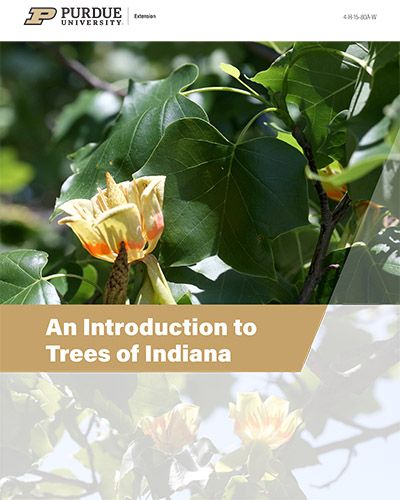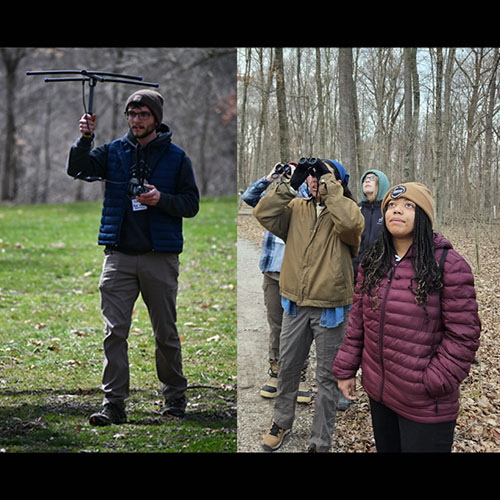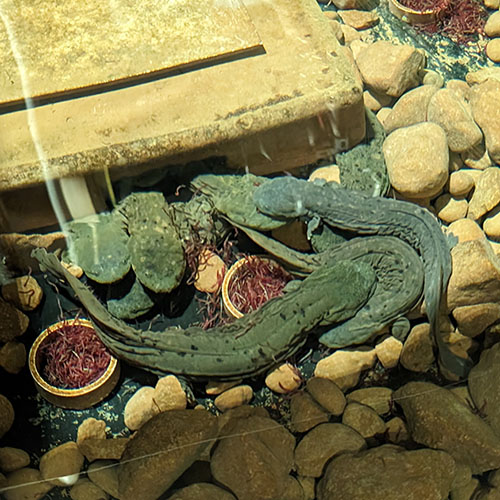In 2023, FNR experienced research advancements, celebrated awards recipients and student accomplishments, shared insight from study abroad trips and internships and spread knowledge about a variety of aquatic sciences, forestry and wildlife topics through extension efforts. Here is a look at the most read FNR news stories from the year.
First, we will look at the Top 10 stories on FNR personnel and research from the FNR news website, then we will share the top five FNR extension stories and five bonus stories written about FNR from other sources.
2023 News Stories from the FNR website
 1 – Researchers Discover Young Hellbender in Blue River - Biologists with the Indiana Department of Natural Resources (DNR) and Purdue University recently documented a very young hellbender salamander, a gilled larva, in the Blue River while conducting routine surveys in south-central Indiana. This discovery is significant because over the past three to four decades, only adult hellbenders have been documented in the Blue River.
1 – Researchers Discover Young Hellbender in Blue River - Biologists with the Indiana Department of Natural Resources (DNR) and Purdue University recently documented a very young hellbender salamander, a gilled larva, in the Blue River while conducting routine surveys in south-central Indiana. This discovery is significant because over the past three to four decades, only adult hellbenders have been documented in the Blue River.
2 – Researchers Aim to Understand Endangered Least Bell's Vireos - Pat Zollner, professor of wildlife science in the Purdue Department of Forestry and Natural Resources, is the principal investigator on a research project looking at “Alternative Management Strategies to Address Multiple Interacting Stressors on Least Bell's Vireo Populations,” thanks to $1.6 million in funding from the U.S. Army Engineer Research and Development Center (ERDC).
3 – Tales from FNR with Professor Emeritus Carl Eckelman - Professor emeritus Carl Eckelman came to Purdue as an undergraduate in 1956 and never left, completing his bachelors, masters and doctorate degrees and eventually becoming part of the faculty, a position he held from 1968 until his retirement in 2018.
4 – FNR Names Dave Case as Lifetime Achievement Award Recipient - Purdue FNR is proud to name Dave Case as its 2023 FNR Lifetime Achievement Award honoree. Case made his impact on the natural resources field as the founder, president and owner of D.J. Case & Associates.
5 – FNR Field Reports: Rachel Kraus - Senior wildlife major Rachel Kraus worked as a summer intern in the Research Experience for Undergraduates program (REU) at the University of Wisconsin-Stevens Point (UWSP) Cooperative Fishery Research Unit, after finding the position on the FNR job board.
6 – Osmon Named FNR Distinguished Alumnus - Purdue FNR is proud to honor Trent Osmon with its 2023 FNR Distinguished Alumnus Award. Osmon has worked at Naval Surface Warfare Center Crane since 2000, first as forester until 2010, then Forestry Program Team Lead and now as the Environmental Division Supervisor on the naval installation.
7 – Community Participation Needed for Maple Syrup Survey – A survey aimed at gathering insights from maple syrup producers regarding their production practices and challenges, is available online now. The survey is part of a research project by Dr. Mo Zhou and graduate students Jean Fritz Saint Preux and Bindu Paudel, who are working with both maple syrup producers and consumers to craft a marketing strategy aimed at increasing consumption and production in the state of Indiana.
8 – FNR Field Report: Ruth Bowers Sword - Imagine living in a tent in Tanzania, its canvas walls acting as the only barrier between you and the jungle and its wild inhabitants, from chimpanzees to elephants and venomous snakes. Imagine using a cup of cold stream water as your only source of cleansing. Imagine traversing rough terrain, following guides using machetes to cut their way through the dense jungle, and barely being able to communicate with them in their native language.
9 – Meet FNR Outstanding Freshman Alex Early - Wildlife major Alex Early, a freshman representative on the FNR Student Council and a member of the Purdue Student Chapter of The Wildlife Society, was named as FNR Outstanding Freshman for the 2022-23 school year.
on the FNR Student Council and a member of the Purdue Student Chapter of The Wildlife Society, was named as FNR Outstanding Freshman for the 2022-23 school year.
10 – Tales from FNR with Professor Emeritus Bill Hoover - Before embarking on a 40-plus year career guiding students and constituents across the state on the topics of timber tax and forest economics, becoming known as the Purdue Forestry and Natural Resources historian or pitching in on various community projects to promote forest maintenance and recreation, Dr. Bill Hoover began his career of service in the U.S. Army Corps of Engineers as a basic training officer and later a combat engineering battalion operations officer in Vietnam.
Top 5 Extension Stories on the FNR News Page in 2023
Our most read stories from the extension realm came from the Intro to Trees series, which gave readers a glimpse into common trees of Indiana by sharing about all of the species featured in the new extension publication “An Introduction to Trees of Indiana.” Each story featured each species including how to identify it, where to find it and how the wood is used.
identify it, where to find it and how the wood is used.
1 – Intro to Trees of Indiana: Osage Orange - Meet the Osage Orange or Maclura. Also known as the hedge apple, this species has oval shaped leaves with point tips, twigs with sharp thorns, fibrous looking bark with an orange undertone, and large yellow-green colored bumpy fruit. While this species is not native to Indiana, it is found throughout the state, where it was planted for fence rows and fence post plantings due to its decay resistant wood.
2 – Intro to Trees of Indiana: Red Cedar - Meet Eastern red cedar or Juniperus virginiana, one of the most common coniferous trees in Indiana. This evergreen tree, also known as aromatic cedar, is unique in that it has both scale-like and sharp-pointed leaves. The red cedar features a shreddy, gray-brown bark on both the trunk and branches, and it produces a small cone, which resembles a berry that is blue in color.
3 – Intro to Trees of Indiana: White Pine - Meet the eastern white pine or Pinus strobus, the only five-needled pine native to Indiana. Each bundle of needles or fascicle, has five needles, which are typically between two and four inches long and blue green in color. The bark is dark and smooth in young trees and heavily furrowed in older trees. The cones are up to eight inches long, have relatively thin scales and often covered in white sap or pitch.
4 – Intro to Trees: Redbud - Meet the Redbud or Cercis canadensis. The alternately held leaves of this small tree are heart-shaped with smooth edges and that measure three to five inches long. The clusters of pink, lavender and even magenta flowers of this species appear in the early spring before the leaves open. The redbud is in the broad legume family and, as such, its fruit is a small pea-pod, approximately three inches long, which is flat with a very thin skin.
inches long, which is flat with a very thin skin.
5 – Intro to Trees: Black Walnut - Meet Black walnut or Juglans nigra, which has compound leaves with several pairs of leaflets along the individual leaf stems. The leaves, which are arranged alternately on the twigs, can be between one to two feet long. The bark has long, strong running ridges, while the species produces nuts, which are ridged and rounded with very heavy shells encased in a thick yellow-green husk.
Links to all posts related to the Intro to Trees series are available online on the Fifty Common Trees of Indiana page.
More FNR Extension posts are available on the FNR Extension website and GotNature! blog. A full look at the top stories from the blog and extension website is available at FNR's Top Extension Stories of 2023.
Top 5 Stories About or Featuring FNR Personnel in 2023
Stories about FNR personnel and research and featuring the expertise of FNR faculty and staff were written by several other entities across the university and country. Here are a few of the top stories written outside the department. 
1 - $10 Million USDA Grant Targets More Midwestern Seafood Production and Consumption - Purdue University has received a five-year, $10 million grant from the U.S. Department of Agriculture to increase the production of seafood, also known as “blue food,” which is healthier and more sustainably produced than land-based foods. With the USDA funding, Purdue researchers will build a pilot-scale integrated aquaponics system on campus, where some lab-scale components already exist, to produce tilapia and lettuce. Paul Brown, professor of forestry and natural resources, operates experimental aquaponics systems in the Aquaculture Research Lab.
2 – Purdue Launches New AI Based Global Forest Mapping Project - Purdue University’s Jingjing Liang has received a two-year, $870,000 grant from the World Resources Institute to map global forest carbon accumulation rates. Liang is developing an artificial intelligence model that will combine information collected about billions of trees measured on-site with satellite and other geospatial data to map local forest growth rates throughout the global forest range.
3 – Purdue Announces New USGS Cooperative Research Unit – A dream half a century in the making is finally a reality. Starting this year, Purdue will be home to the Indiana Cooperative Fish and Wildlife Research Unit, a partnership with the U.S. Geological Survey (USGS), U.S. Fish and Wildlife Service, the Indiana Department of Natural Resources, and the Wildlife Management Institute. It will be the 43rd USGS Cooperative Research Unit (CRU) in the country, and the first in Indiana.
4 – $10 Million USDA Grant to Fuel Economic Resilience and Sustainability in Eastern U.S. Forests - The U.S. Department of Agriculture has awarded a $10 million grant to Purdue University to help landowners and stakeholders better adapt their forests to increasingly complicated economic and climate conditions in the Eastern U.S. Called PERSEUS (Promoting Economic Resilience and Sustainability of the Eastern U.S. Forests), the project will guide landowner decision-making via a digital framework for visually representing current and future forest trends so that landowners will have data upon which to base their decisions.
5 – Unexpected Plants and Animals of Indiana: Eastern Massasauga Rattlesnake – Purdue extension wildlife specialist Brian MacGowan is quoted in this story about eastern massasauga rattlesnakes or Sistrurus catenatus. These small, venomous pit vipers live in the shallow wetlands of Canada and the north half of the American Midwest, including parts of Steuben County in Indiana.





